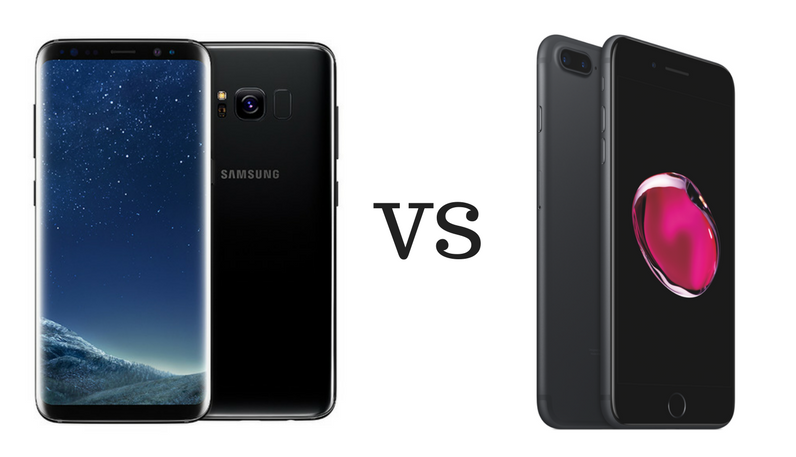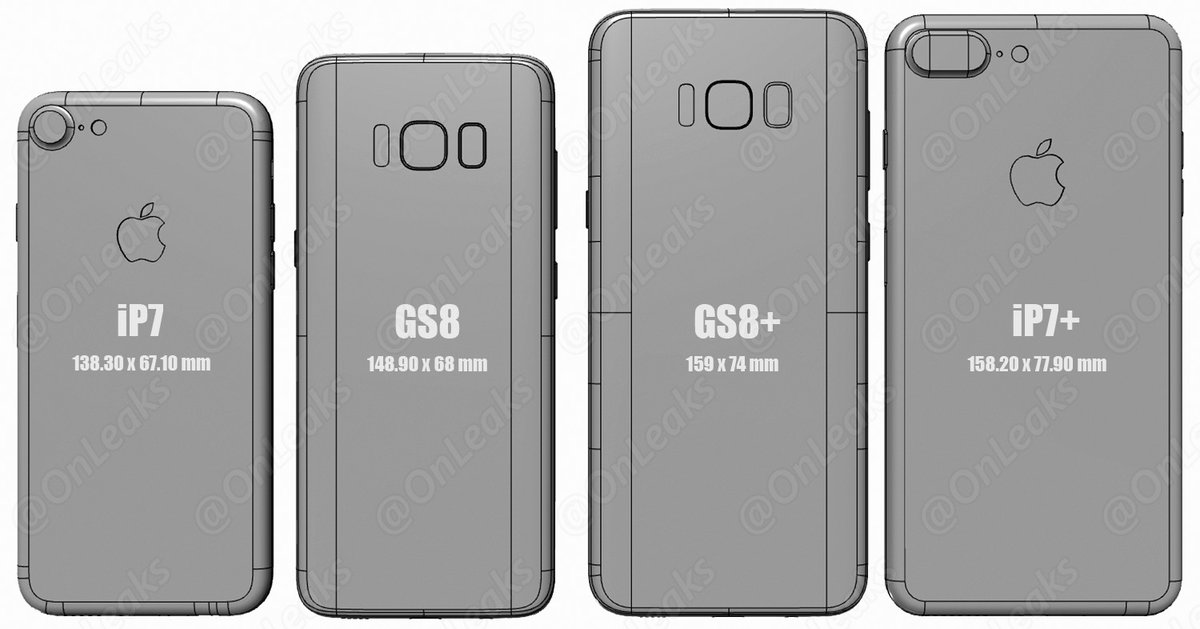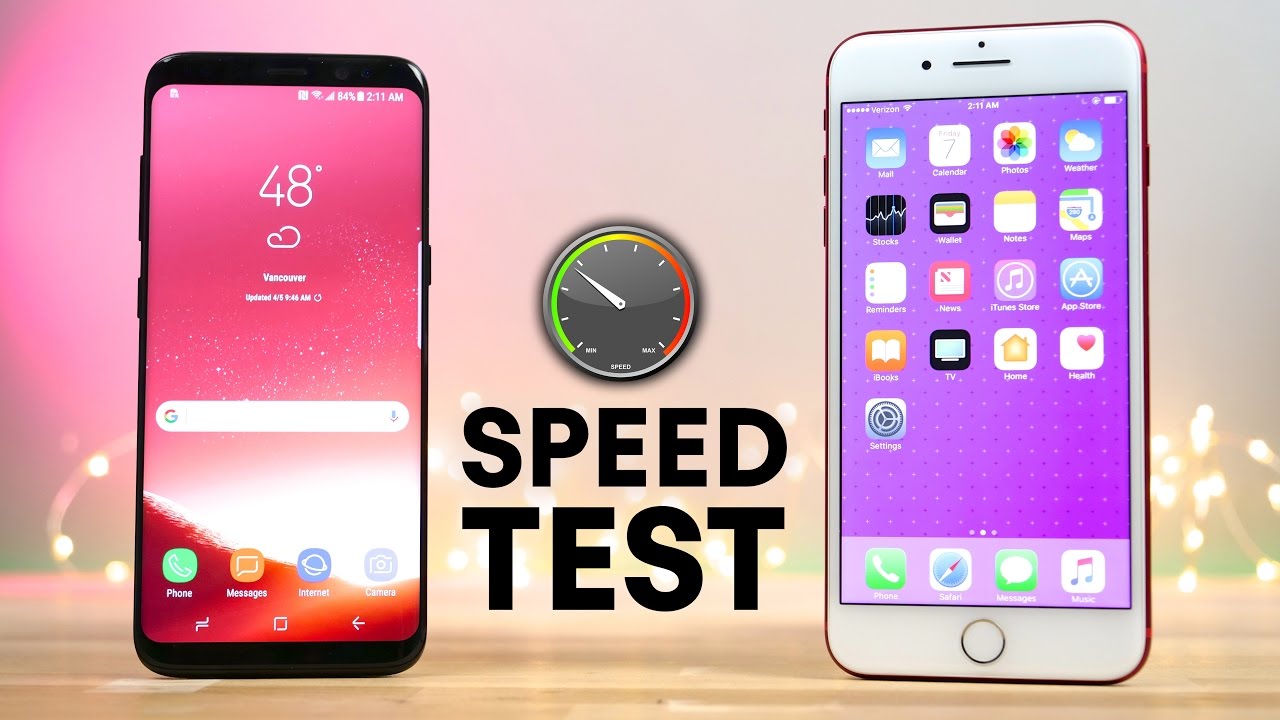Apple iPhone 7 has finally found a worthy rival in the face of Samsung's Galaxy S8. While awaiting the official release of iPhone 8, which will take place almost six months later, we can indeed highlight some reasons in favor of choosing the Samsung Galaxy S8 instead of iPhone 7.

Galaxy S8 came out six months later than iPhone 7, which should mean a certain technological gap. We will try to find out if it is really better.
See also article: Samsung Galaxy S8 and S8 + vs. Apple iPhone 7 and 7 Plus: Feature Comparison.
Design
In terms of design, the clear winner is the Samsung Galaxy S8. The bezel-less design of the device with the Infinity display on the front looks very futuristic. iPhone 7 with its traditional design developed three years ago is clearly losing the competition. The bezel-less design makes the Galaxy S8 look compact even with its large 5.8-inch display. A glass body on a metal frame gives the Galaxy S8 the look of a premium device. This design appeared back in 2015 on the Samsung Galaxy S6, but has become more ergonomic since then. New color schemes launched by the company also helped to freshen up the atmosphere.

Both phones are dust and water resistant, although the Galaxy S8 has a better IP certification. The S8's IP68 rating means it can stand in cool water for up to 30 minutes at a depth of 1.5 meters. iPhone 7 is IP67 certified to stay in cool water for no more than 15 minutes and has a maximum depth of 1 meter.
Display
The bezel-less design combined with the Infinity display makes the Galaxy S8's screen bigger and better compared to iPhone 7. The smartphone has a 5.8-inch curved Super AMOLED display with QHD + resolution (2960 x 1440 ) and an aspect ratio of 18.5: 9. This new format is better suited for multitasking and at the same time is convenient for using a smartphone with one hand. In terms of image quality, DisplayMate ranks the Infinity Display with an A + rating, the highest ever awarded. In addition to high resolution, brightness and contrast settings, Infinity DIsplay on the Galaxy S8 is the first display with Dolby Vision technology. It is also HDR-10 certified.

iPhone 7 still has a 4.7-inch Retina HD IPS display LCD with a resolution of 1334 x 750. The benefits of this display are excellent viewing angles, brightness, saturation and contrast settings. It also supports a wide range of DCI P3 color space for better effects. DisplayMate also named the display as the best LCD on smartphones, 'at the edge of technology LCD'. However, the 4.7-inch front panel iPhone simply cannot match the excellent QHD + Super AMOLED screen of the Galaxy S8 in terms of clarity, brightness, color and other aspects.
The days when LCD – screens outnumbered AMOLED are irrevocably gone. Samsung has made a significant breakthrough in this area and now AMOLED – displays are very promising. It is not surprising if Apple plans to implement iPhone 8 display AMOLED.
LCD – display iPhone 7, however, has the huge advantage of 3D Touch. This pressure-sensing technology allows users to interact with the operating system to a whole new level. What is displayed on the screen is directly determined by the level of pressure applied by the user. While major applications for iOS benefit from the emergence of 3D Touch, the technology hasn't been as big of a digital entertainment breakthrough as Apple originally saw it.
Processor, RAM and disk space
The Samsung Galaxy S8 is the first flagship smartphone with Android based on the Qualcomm Snapdragon 835 chipset. The octa-core 10nm CPU runs at 2.35 GHz and is complemented by the excellent Adreno 540 GPU. is based on Samsung's own Exynos 8895 chipset, which is also equipped with an eight-core 10nm processor. Both chipsets use big.LITTLE technology to balance performance and battery life.
iPhone 7, on the other hand, is based on the Apple A10 Fusion chip with four cores — two running at high frequencies and two at low frequencies to maximize performance while reducing power consumption .

Despite the 14-16nm process technology, the A10 Fusion outperforms the Qualcomm and Exynos chipsets used in the Galaxy S8. When it comes to performance, the A10 is a cut above it, leaving other chipsets no chance of winning in single threaded applications. Only with active use of multithreading can Qualcomm and Exynos chips somehow compete with it.
There is another important factor to consider – Samsung devices are known to degrade in performance after a few months. Although this happens with iPhone, the loss does not become noticeable until a year or two after the acquisition. Galaxy S8, on the other hand, if you draw conclusions from previous models, will start to slow down much faster.
iPhone 7 is equipped with two gigabytes of LPDDR4 RAM, while the Galaxy S8 has four gigabytes available. However, extra RAM doesn't necessarily mean a win for the Galaxy S8. The point is that iOS uses resources more efficiently, and a lower screen resolution iPhone 7 means that applications require less memory than the S8. This is compounded by Samsung's design features, which consume a lot of resources.
When it comes to multitasking, the Galaxy S8 does a little better at keeping more apps in memory. But many other phones Android with 4 gigabytes of RAM significantly outperform him.
Smartphones' approaches to disk space are very different. The Galaxy S8 is only available with 64GB of internal storage, while the iPhone 7 offers options of 32, 128, or 256GB. iPhone 7 uses a high speed PCIE based solution — one of the most advanced on the market. The NAND-based persistent memory that characterizes the Galaxy S8 is also considered one of the fastest, but still falls short of the narrowly targeted platform Apple.

While the Galaxy S8 is only available with 64GB of storage, it does offer a microSD card slot. This means that users can expand the storage size with cards up to 1 terabyte. This cannot be done with iPhone 7: models with a lot of disk space are expensive.
Camera
Both phones have a 12MP camera on the back, but they are still very different. The camera iPhone 7 has an f / 1.8 aperture, optical image stabilization and a pixel size of 1.22 microns. The Galaxy S8, on the other hand, hasn't changed since the days of the Galaxy S7: a 12MP camera with 1.4μm pixels, OIS and Dual Pixel technology.
The slightly wider aperture and Dual Pixel allow the Galaxy S8 to bypass iPhone 7 in low light conditions. To improve camera performance, Samsung uses computational tricks – like Google with their Pixel smartphones. This means that, like the Pixel, the Galaxy S8 quickly takes three shots in a row and combines them into one with lower noise, higher dynamic range, and better reflection of details. If Samsung's implementation is even half as good as the Google Pixel, this smartphone's camera should be great at shooting in low light.
Both phones are also capable of capturing 4K video, capturing live photos, applying slow motion and more.
As for the front-facing cameras, the iPhone 7 boasts a 7MP f / 2.2 and Retina Flesh device, while the Galaxy S8 has an 8MP f / 1.7 autofocus camera. Autofocus should allow the S8's front camera to take more good selfies, while iPhone Retina Flash support gives it a win in low light.
Iris scanner, face recognition and other sensors
Although both phones have the same basic set of sensors, including accelerometer, proximity sensor, gyroscope, fingerprint scanner and more, the Samsung Galaxy S8 also has an additional set that is missing in iPhone 7. On the front, the Galaxy S8 has iris scanner. Samsung pioneered this technology in the Galaxy Note 7 and has now improved it even further. The smartphone also supports face recognition, which is not on iPhone 7. However, the recognition system is rather imperfect: it has been shown that it can be easily deceived with a photo.
Finally, the Galaxy S8 has a heart rate scanner, although there isn't much benefit from it.
Battery
Samsung Galaxy S8 comes with a 3000 mAh battery, while iPhone 7 – 1960 mAh. Both smartphones have non-removable batteries. Although the Galaxy S8 has a larger battery capacity, it uses more power due to its larger screen and more demanding sensors. Therefore, it becomes difficult to tell which phone provides the longest battery life — among other things, it depends a lot on how you use the device.
However, the Galaxy S8 has two advantages: fast charging and wireless charging. The S8's battery charges from zero to one hundred percent in just one hour. iPhone 7, by comparison, doesn't support any kind of fast charging technology — what's more, it takes an especially long time to charge with its factory 5V charger. In addition, the Galaxy S8 can wirelessly charge quickly, while the iPhone 7 cannot at all. Of all the devices on the market, only the Galaxy S8 supports both Qi and PMA — various wireless charging technologies.
Price
The Samsung Galaxy S8 and iPhone 7 smartphones are available from all major suppliers worldwide. While the Galaxy S8 is mostly available for pre-order at the moment, it will be available at almost any decent store by the end of the month.
The cost of both devices is about the same. iPhone 7 with 32GB of memory costs $ 649, with 128 and 256GB – $ 749 and $ 849, respectively. The unlocked Galaxy S8 will go on sale May 9 for $ 724.99. It is also possible to purchase the unlocked version from the carrier, but in this case it will cost a little more.
Both smartphones have a number of advantages and disadvantages. The design, Infinity display, expandable storage, fast charging and rear camera of the Galaxy S8 are far superior to the hardware iPhone 7. On the other hand, the latter outperforms the Galaxy S8 in app handling, performance, security and privacy settings.
Which smartphone would you prefer – Galaxy S8 or iPhone 7? Why? Share your opinion in the comments!
